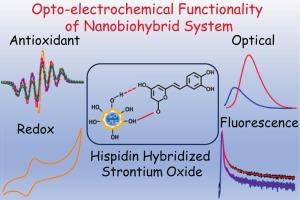Hispidin hybridized strontium oxide: a nanobiohybrid system for opto-electrochemical functionality
IF 5.4
3区 化学
Q1 CHEMISTRY, INORGANIC & NUCLEAR
引用次数: 0
Abstract
Strontium oxide (SrO) and polyphenol-based research on bone health, tissue engineering, anti-oxidant and anti-inflammatory are available in literature, yet the opto-electrochemical characteristics of SrO incorporated with polyphenol-derived from fungus (mushroom metabolite, Hispidin) remains unexplored. Here, we report the solvothermal-mediated synthesis of SrO nanoparticles and its surface modification with Hispidin (His) via PEGylation using ultrasonochemical process. As synthesized SrO-PEG/His exhibit absorption bands at 290 and 369 nm ascribed to π-π* and n-π* transitions, respectively. Photoluminescence study of SrO-hybridized Hispidin shows a visible light emission band centered at 427 nm, enabling a blue shift from the pristine Hispidin. FT-IR spectral analysis confirmed the occurrence of interaction between C![]() O functional group of Hispidin and PEGylated SrO. Electron and atomic force micrograph suggest the formation of nanoscale particles with an average particle size distribution of 50 nm and roughness factor of 0.89 nm, respectively. Electron paramagnetic resonance spectral analysis affirmed that SrO-PEG/His exerts a dosage dependent (0.1 to 1 mg/mL) radical scavenging activity against standard free radical. Preliminary electrochemical studies, from cyclic voltammetry, on SrO-PEG/His modified glassy carbon electrode suggest the quasi-reversible redox behavior, following 2e−/2H+ transfer at the electrode-electrolyte interface. Observed results ensured that the opto-electrochemical characteristics of the synthesized nanobiohybrid system are useful for antioxidant and sensor probe construction, paving the way for futuristic applications in theranostics.
O functional group of Hispidin and PEGylated SrO. Electron and atomic force micrograph suggest the formation of nanoscale particles with an average particle size distribution of 50 nm and roughness factor of 0.89 nm, respectively. Electron paramagnetic resonance spectral analysis affirmed that SrO-PEG/His exerts a dosage dependent (0.1 to 1 mg/mL) radical scavenging activity against standard free radical. Preliminary electrochemical studies, from cyclic voltammetry, on SrO-PEG/His modified glassy carbon electrode suggest the quasi-reversible redox behavior, following 2e−/2H+ transfer at the electrode-electrolyte interface. Observed results ensured that the opto-electrochemical characteristics of the synthesized nanobiohybrid system are useful for antioxidant and sensor probe construction, paving the way for futuristic applications in theranostics.

Hispidin杂化氧化锶:光电电化学功能的纳米生物杂化系统
关于氧化锶(SrO)和多酚在骨骼健康、组织工程、抗氧化和抗炎方面的研究已有文献,但SrO与真菌衍生的多酚(蘑菇代谢产物,Hispidin)结合的光电电化学特性仍未被探索。在这里,我们报道了溶剂热介导的SrO纳米颗粒的合成和Hispidin (His)的表面修饰,通过聚乙二醇化超声化学过程。合成的SrO-PEG/His在290 nm和369 nm处分别表现出π-π*和n-π*跃迁的吸收带。sro杂化Hispidin的光致发光研究显示,在427 nm处有可见光发射带,使原始Hispidin发生蓝移。FT-IR光谱分析证实了Hispidin CO官能团与聚乙二醇化SrO之间存在相互作用。电子显微镜和原子力显微镜显示,形成的纳米级颗粒的平均粒径分布为50 nm,粗糙度系数为0.89 nm。电子顺磁共振谱分析证实,SrO-PEG/His对标准自由基具有剂量依赖性(0.1 ~ 1mg /mL)的清除活性。通过循环伏安法对SrO-PEG/His修饰的玻碳电极进行的初步电化学研究表明,在电极-电解质界面发生2e−/2H+转移后,具有准可逆的氧化还原行为。观察到的结果确保了合成的纳米生物混合系统的光电电化学特性对抗氧化剂和传感器探针的构建是有用的,为未来在治疗学中的应用铺平了道路。
本文章由计算机程序翻译,如有差异,请以英文原文为准。
求助全文
约1分钟内获得全文
求助全文
来源期刊

Inorganic Chemistry Communications
化学-无机化学与核化学
CiteScore
5.50
自引率
7.90%
发文量
1013
审稿时长
53 days
期刊介绍:
Launched in January 1998, Inorganic Chemistry Communications is an international journal dedicated to the rapid publication of short communications in the major areas of inorganic, organometallic and supramolecular chemistry. Topics include synthetic and reaction chemistry, kinetics and mechanisms of reactions, bioinorganic chemistry, photochemistry and the use of metal and organometallic compounds in stoichiometric and catalytic synthesis or organic compounds.
 求助内容:
求助内容: 应助结果提醒方式:
应助结果提醒方式:


